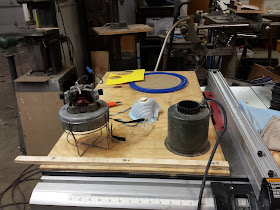More shop improvements. Until now, the table saw was connected to a very old and somewhat crappy Craftsman shop vacuum. It did a barely adequate job of dust collection and its joke of a filter clogged laughably quickly. Still, it is the only tool in the shop that had any kind of dust collection.
I recently purchased a small plastic cyclone separator (the Oneida, Dust Deputy) to turn it into a two-stage unit. The purpose of a cyclone is to separate out as much of the sawdust and wood chips from the air stream as possible before it gets to the filter. This makes for cleaner air, longer lasting filters and better air flow. However, converting it would take a little modification and a fair bit of fabrication.
Unless you buy one of their rather expensive kits, the Dust Deputy does not come with any accessories, gaskets or hardware. What you get is a molded plastic cone with an air intake on the side and an air outlet at the top and a mounting flange at the bottom. That's it. A single piece of molded plastic, and it costs about $50. That means I will have to find my own way to connect it to my shop vacuum system.
I started by removing the motor from the lid of the main dust canister of my Craftsman vacuum. The lid fits the canister with an air tight seal, and it has a hole in the top (where the motor mounted) which is just about the right size for the Dust Deputy's mounting flange. Unfortunately, it is not centered, and there are some other issues that prompt me to make my own flange out of MDF. My MDF flange attaches to the metal canister lid with four bolts and an EVA foam (2mm craft foam) gasket. The Dust Deputy attaches to the MDF flange with six bolts and another EVA foam gasket. I also had to plug up the old air intake hole in the metal lid with a piece of luan.
Next I turned toward the motor. I took the housing off the motor and removed the old crappy filter bag and cage. I planned to replace it with a high efficiency aftermarket filter for shop-vacs.
Since the motor used to mount directly to the canister lid, I would now need a new housing for the motor and filter. It doesn't need to be very big, because the bulk of the sawdust will go into the main canister out the bottom of the cyclone separator. Only a little very fine dust will make it to the filter and motor. A three gallon bucket with nice ridged walls (it will be under vacuum) and a lid will make a fine housing. This too required a flange to be fabricated, as the plastic bucket lid was far too flimsy. So I made a flange out of hard board on the top and a ring of MDF on the bottom and bolted them together, sandwiching the bucket lid in between. The hardboard was screwed into the motor mounting holes and also the MDF ring grips the bottom of the motor, around the impeller and acts as a backstop for the filter.
I got lucky in so far as the bottom of the bucket had a little ring molded into it at the center, which fit just perfectly into a PVC reducer coupling. The other end of the coupling fit perfectly onto the Dust Deputy's air outlet. I cut out the bottom of the bucket in the center of the ring and fit the coupler between the bucket and cyclone. I could have just cut the hole and pushed the cyclone's air outlet pipe directly in it, but I was worried about getting an airtight fit.
At this point, with the motor wired back up, the system was functional, but the whole affair was wobbly and top heavy. It needed more support. Still, I took this opportunity to do a test. I sucked up a mess of sawdust with it to see how much dust got past the cyclone, and to make sure the system was airtight.
As you can see from the pictures above, nearly all the sawdust ended up in the main canister under the cyclone, and only a small amount of very fine dust ended up in the bucket or on the filter. Even this short test generated a significant amount of static electricity from friction between the sawdust and the cyclone. In the near future, I will need to add a ground wire to the system to prevent static buildup.
I disassembled the unit and set about making a support structure. This support structure was made from 3/8" threaded rod, four sticks of it, each about 16" long. They would bolt through the lower flange where the cyclone mounts to the canister lid, and again through an upper flange that the bucket will sit on, taking a significant portion of the weight of the bucket and motor off of the cyclone itself, and providing a wider, more stable base.
And that's it! A working two-stage cyclone separator shop vacuum. Aside from that one test, I have yet to put it to use ( just finished it a couple of days ago). It will likely get re-attached to the table saw, and may end up doing some general shop cleaning, until I get my big centralized dust collection system installed. Then it will get used like a regular shop vac, as the table saw, and most of the other machines, will get connected to the centralized system. But that could be quite a while yet before that system is installed.
It is still a bit tall and ungainly, but that is the price you pay for efficient dust collection.

















No comments:
Post a Comment